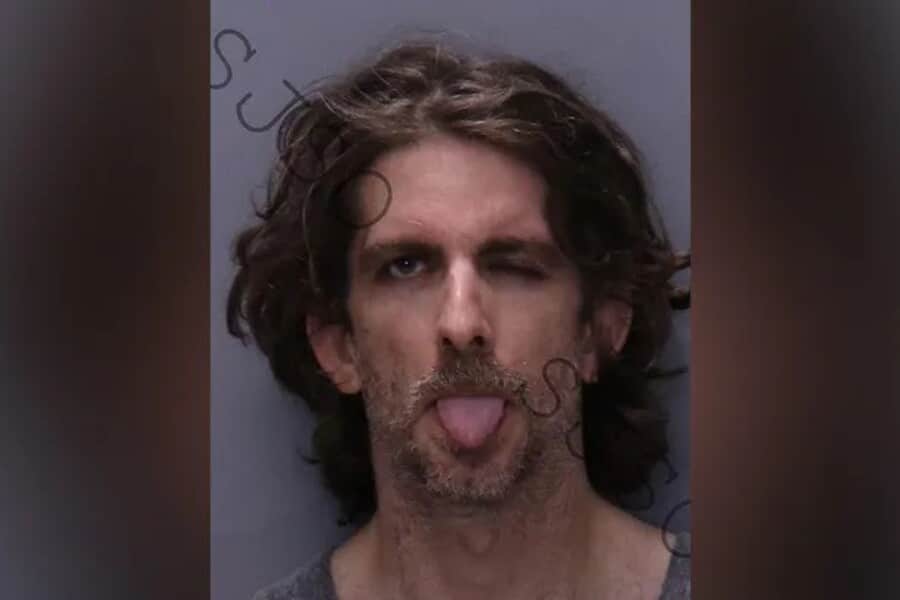
In a startling act of public dissent, Max Azzarello, 37, from St. Augustine, Florida, self-immolated outside the Manhattan courthouse during Donald Trump’s trial, drawing immediate attention and horror from bystanders.
Moments before this extreme protest, Azzarello distributed numerous pamphlets that bore cryptic messages and directed readers to his extensive online manifesto. This document elucidated a variety of conspiracy theories, accusing global elites of orchestrating political and social tyranny.
As Azzarello set himself ablaze, the papers fluttered around Collect Pond Park, where shocked onlookers witnessed the grave culmination of one man’s profound distress and desperation over perceived governmental malfeasance.
The Incident
On a brisk afternoon, Max Azzarello, identifying himself as an “investigative researcher,” entered Collect Pond Park adjacent to the Manhattan courthouse. It was approximately 1:30 p.m. when he began his alarming act of protest; he scattered numerous pamphlets that bore links to his manifesto, detailing a range of conspiracy theories. After dispersing these papers, he poured gasoline over his body.
Striking a match, Azzarello ignited the gasoline, enveloping himself in flames in front of stunned onlookers. Quick-acting bystanders and responding authorities rushed to his aid, using coats and blankets to smother the flames that severely injured him.
Despite their efforts, he sustained critical injuries and was urgently transported to a nearby burn center. The incident, captured by various witnesses and security cameras, has sparked widespread media attention and a discussion on the intersection of mental health and radical political beliefs.
The severity of the situation was underscored by the immediate and visceral reaction of the public and the swift response of emergency services.
Azzarello’s Manifesto
Before his dramatic protest, Max Azzarello had meticulously crafted a detailed manifesto entitled “The Ponzi Papers,” which he conspicuously updated just moments before his self-immolation.
In this extensive document, he articulated a chilling vision of an imminent totalitarian regime, purportedly being orchestrated by a cabal of global elites from the political and corporate realms.
Prominent figures such as Presidents Trump and Biden, along with tech billionaires like Mark Zuckerberg and Elon Musk, were implicated in his theories, which suggested they were conspirators in an approaching “fascist world coup.”
Azzarello argued that such a drastic scenario justified equally drastic measures to alert the public, presenting his act of setting himself on fire as a dire need to focus the world’s attention on these potential threats. His manifesto painted a dystopian future, urging an awakening to the manipulations he believed were steering society toward authoritarianism.
Max Azzarello’s background was as eclectic as his beliefs. Once announced as a new growth manager for the nonprofit Strong Towns, his interests ranged from chess and creative writing to Medieval Scandinavian poetry. He hosted a niche podcast dedicated to actress Laura Dern and was involved in a bizarre legal suit against high-profile figures like Bill Clinton, alleging vast conspiracies.
The day before the incident, Azzarello was seen near the courthouse, engaging with reporters and proclaiming cryptic warnings about the trial and its participants. His actions and words painted a picture of a man deeply entrenched in his convictions, driven to desperation by what he perceived as the public’s unawareness of the imminent threat he believed in.
Law Enforcement and Safety Measures
The NYPD acted promptly following Max Azzarello’s self-immolation outside the Manhattan courthouse. Officials characterized the incident as influenced by Azzarello’s belief in various conspiracy theories, highlighting the complex motivations behind his extreme act.
At the time, the location was not considered a high-security threat, suggesting that Azzarello’s actions were unexpected and not foreseen as a direct threat to public safety. However, the dramatic nature of the event and its proximity to a high-profile trial have sparked a reevaluation of security measures in the area.
Discussions are underway among local law enforcement agencies to tighten security protocols and enhance surveillance around critical infrastructures, especially during significant judicial proceedings. This incident has underscored the need for vigilant, adaptive security strategies that can preemptively identify and mitigate potential threats, ensuring the safety of the public and the integrity of judicial processes.
Experts in mental health have commented that such extreme acts of protest may stem from profound psychological distress and a misplaced desire to effect change. This incident highlights the dangerous potential of untreated mental health issues and radical beliefs.
The public and media response was one of shock and confusion, with many condemning the act as unnecessarily violent and self-destructive. The coverage has also sparked debates on the responsibility of social media platforms in spreading conspiracy theories and the role of the public in responding to such crises.
Political analysts have weighed in, noting the growing influence of extremist beliefs on public behavior. They point out that while Azzarello’s actions are extreme, they underscore a broader issue of political disillusionment and mistrust among certain population segments.
Max Azzarello’s tragic act of self-immolation is a stark reminder of the volatile intersection of mental health issues and extremist ideologies. It calls into question the societal and systemic structures that may contribute to such distress and highlights the critical need for comprehensive approaches to mental health, public safety, and the dissemination of information.
As the community and the nation reflect on this incident, one must hope that it fosters a more informed and empathetic dialogue about the complex forces shaping modern political discourse.
This incident, set against the backdrop of a high-profile trial, not only captured immediate media attention but also raised significant concerns about the impact of severe political and social beliefs on individual actions.
The ramifications of this event will likely extend beyond the immediate legal and safety discussions, prompting policymakers, mental health professionals, and civic leaders to examine more deeply the root causes that drive such dramatic demonstrations of protest.





